Oaxaca Mexico Travel Guide for Outdoor Adventurers: The Best Places to Eat, Stay, and Play!
If you’re an outdoor adventurer, this Oaxaca Mexico travel guide will teach you about more than just the best mercados, mole, and mezcal! You will also learn about Oaxaca’s best places to explore by hiking, biking, and rock climbing in this magical place. And, all locations are within an hour’s drive of the city center.
Some of the areas we’ll highlight for you include:
- Monte Alban and Mitla, archeological sites that rival Tulum and Chichen Itza!
- Eco-tourism villages in the Sierra Norte
- Hierve de Agua, a petrified waterfall
- Rock climbing in San Sebastian Tutle
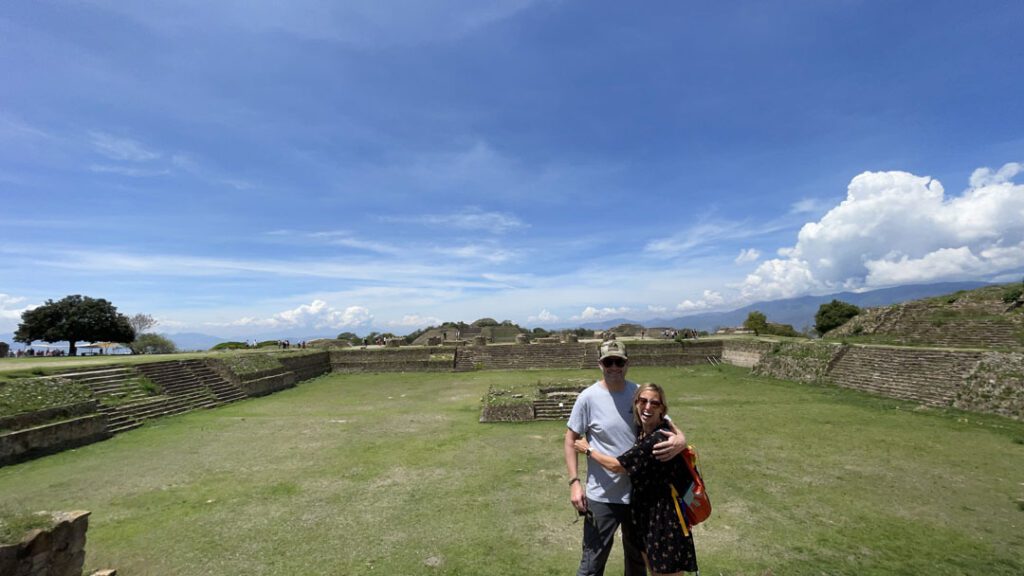
Get ready for lots of walking, especially when visiting the ancient Zapotec city of Monte Alban! Get up early and get the entire place to yourself.
The City of Oaxaca
Oaxaca City or Oaxaca de Juarez is located in the center of the state of Oaxaca. It is well over 5 hours inland from either coast. And, reachable only by traveling across rugged mountain roads. I first heard of Oaxaca from friends that traveled for the epic surf breaks near Puerto Escondido, Huatulco, and Barra de la Cruz. But then, I slowly started hearing more about the delicious moles and the incredible mezcal producers near Oaxaca City. Finally, I dug into books by Chef Alejandro Ruiz The Food of Oaxaca, and Oliver Sacks Oaxaca Journal. I learned so much about this unique Mesoamerican culture that flourished under the Zapotec people, that same culture that the Spanish conquistadors tried to obliterate. I had to come see for myself.
Weather in Oaxaca
Oaxaca City is nestled in between the Sierra Madre and several other mountain ranges and lies at 5,100ft of elevation. It’s also located in the tropics, at about the same latitude as Belize City. So, Oaxaca has warm temperatures year-round. It also has a dry season (October-April) and a rainy season (May-September). But, the rainy season doesn’t necessarily mean that it rains all day. Thunder clouds typically begin to form in the afternoon, with rain beginning close to sunset or later in the evening. We traveled to Oaxaca at the end of May and welcomed the rain to cool off our evenings!
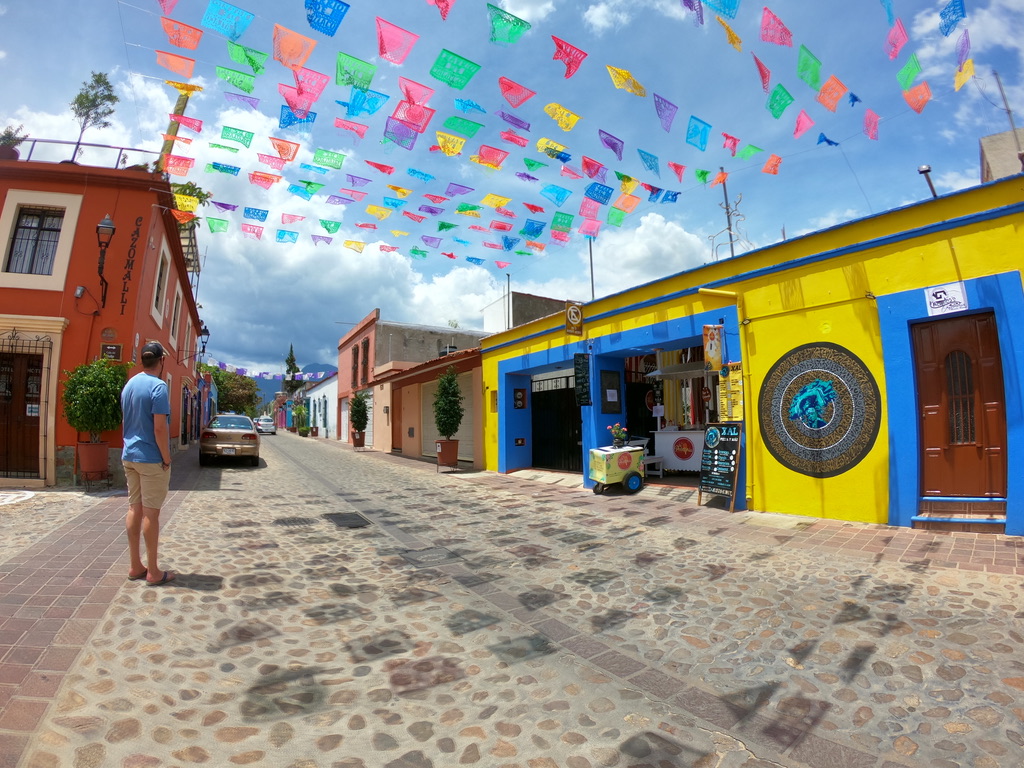
Get up early while it’s cooler outside and explore the older Oaxaca City neighborhoods of Jalatlaco and Xochimilco.
What to Pack for Your Oaxaca Trip
Pack good sandals or sneakers for walking, as you’ll easily get in your 10,000 steps during your trip to Oaxaca! But, keep in mind, Oaxaqueños are often more dressed up compared to Americans. So if you want to blend in, think sundresses and capris instead of board shorts. Leather sandals instead of rubber flip-flops. Fedoras and floppy hats instead of truckers. Oaxaca is not on the coast, so the beach vibe is not really present here.
Historic Places to Visit in Oaxaca
As you walk through the cobblestoned streets and into the central plaza of Oaxaca city, the Zocalo, you will feel as though you are in Spain. And that’s because when the Spanish arrived in Oaxaca in 1521 in search of gold, they made great efforts to colonize the region. However, their exploitation of the land and its people had a devastating effect.
Spanish explorers like Hernan Cortes irrevocably altered life for the Zapotec people. And the entire Aztec empire. Under Spanish rule, historic archeological sites were replaced with Catholic churches. Many were often built right on top of the ruins. Oaxaca valley’s social practices, politics, and religion were Europeanized.
So, as we dive into this Oaxaca Mexico travel guide, and sites of cultural importance, keep in mind what the indigenous people of Oaxaca have experienced.
Here are some of our favorite places you can easily explore by foot:
- Barrio Jalatlaco and Xochimilco, the oldest neighborhoods in Oaxaca. Quieter and charming parts of Oaxaca with colorful homes lining each cobble-stoned street
- Jardin Etnobotanico de Oaxaca, featuring native plants of the Oaxacan region, and available by tour only
- The Church of Santo Domingo de Guzman a Dominican Church that has been fully restored, the interior decorated with over 60,000 sheets of 23.5 karat gold!
- Catedral de Oaxaca, located in the Zocalo
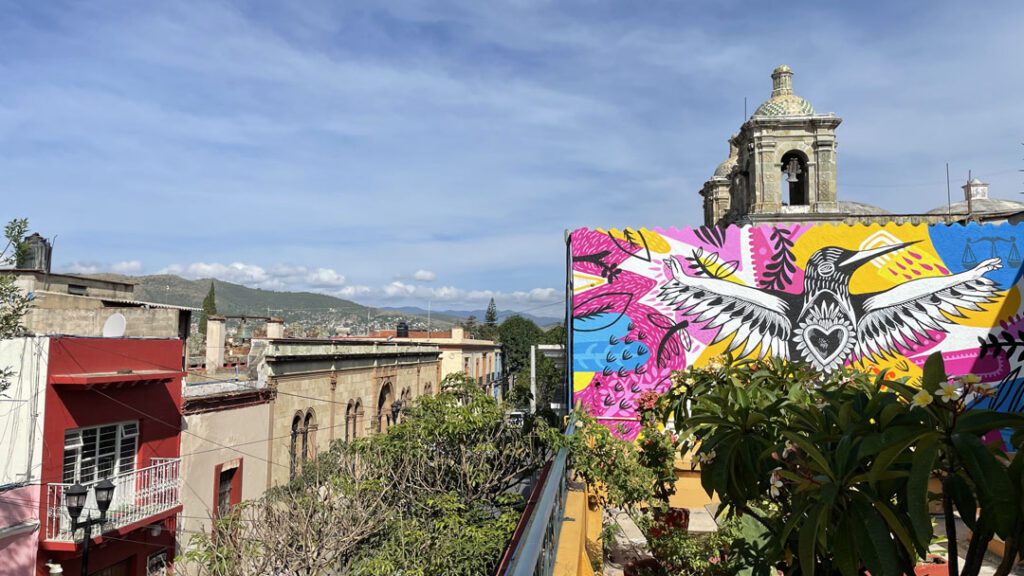
There’s so much to art, culture, and history to be found just walking around Oaxaca city.
Shopping in Oaxaca City
Take your time strolling through the plazas surrounding the Zocalo and Santo Domingo…did I mention you should prep to do lots of walking? Dozens of carts line the more pedestrian-friendly streets, with vendors selling everything from sombreros to leather satchels. Beautifully painted pottery and intricately painted wood sculptures. If you are here to shop, you will not be disappointed. Bring an extra bag, or ensure your wheelie suitcase has plenty of room!
Keep in mind that these local Oaxacan artisans were hit hardest by the coronavirus pandemic. They depend on tourism dollars. So please think twice about pulling out your iPhone or camera to capture the gorgeous woven rugs and daily traffic in the mercados, and then leaving without buying anything from the locals.
Here are a few places to spend your pesos:
- Aripo, Instituto Oaxaqueno de las Artesanias
- Estampa Galeria
- La Plaza de Artesanias + La Casa de las Artesanias
- Mercado 20 de Noviembre
- Mercado Organico el Pochote
Other shopping centers and markets outside of Oaxaca City:
Tlacolula Market is about a 35-minute drive to the East of Oaxaca City. It’s open daily, but triples in size on Sundays. Head to Tlacolula for your produce, flowers, and food stalls.
Teotitlán del Valle is just across the highway from Tlacolula, and it’s where you will find dozens of traditional master weavers. Most weaving was done by the Zapotec people on a backstrap loom, which is still used in some locations today. Rugs and other textiles made thousands of years ago were created with cotton as there were no sheep in ancient times. Now, most of the weaving is primarily done with wool in Teotitlán del Valle. And, weavers use natural dyes from plants and flowers to create yellows and greens, indigo for blue, and they get the reds, oranges, and purples from the cochineal insect.
Our favorite weaving family was that of J. Isaac Vasquez. The family’s workshop and gallery, The Bug in the Rug, showcases the beautiful work of master weavers.
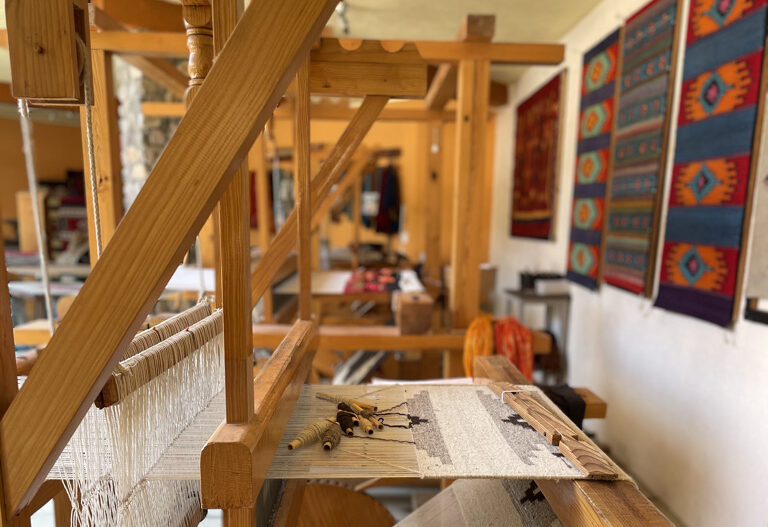
The village of Teotitlan del Valle has a long weaving tradition that dates back to Prehispanic times.
Best Places to Enjoy the Local Cuisine of Oaxaca
By the time we landed, we already had extensive lists curated from friends of all the chic Oaxacan restaurants, mezcalerias, and quaint cafes. Oaxaca’s food scene is outstanding, and often the main reason people visit the city. The agricultural crops that remain a staple of the oaxaqueños cuisine are tomatoes, corn, beans, chilis, and squash. Most of which are still farmed in the same way as they were were thousands of years ago.
Be bold and try new things! Did you know there are over 7 different types of mole? Also be sure to try the Oaxacan cheese, chocolate, and chapulines (aka deep-fried grasshoppers)!
Best Oaxacan Restaurants:
- Ancestral Cocina Tradicional: simple but delicious rustic outdoor patio dining, tucked away in Xochimilco neighborhood
- Boulenc: the best spot for takeaway croissants, cafe, or head a few doors down to their outdoor patio for a full meal
- Casa Oaxaca: by Chef Alejandro Ruiz, features beautifully crafted Oaxacan cuisine, and rooftop dining with a view of Santo Domingo
- Guajalote de Oro: a cozy bar with good apps and cocktails
- Hotel Los Amantes: best mezcal cocktails, full menu, rooftop dining with a view of Santo Domingo
- Las Quince Letras: traditional Oaxacan cuisine
- Los Danzantes: outdoor courtyard dining with delicious traditional Oaxacan food served beautifully
- Pitiona: Great cocktails, exceptional menu, and rooftop dining with a view of Santo Domingo
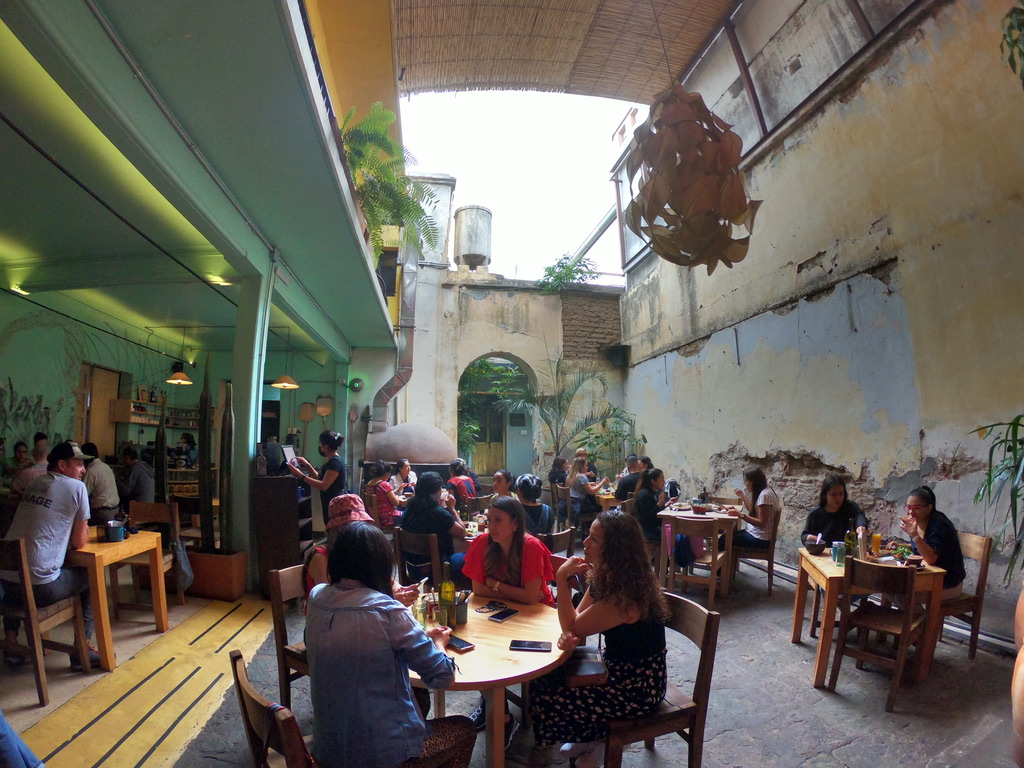
Outdoor dining can be found throughout the city, with Boulenc being one of our favorites for frothy cups of chocolate con leche and delicious almond croissants!
Best Mezcal Distilleries in Oaxaca
Save at least 1 day to explore the mezcal distilleries outside of Oaxaca city. These can primarily be found in one of 2 areas: Santa Catarina Minas, just south of Oaxaca City, and Santiago Matatlán, about an hour east on the way to Mitla. Santa Catarina Minas and Santiago Matatlán combined are home to over 500 mezcal distilleries or palenques!
A common question we heard at mezcal tastings: What’s the difference between tequila and mezcal?
In case you too are wondering the same, mezcal and tequila are both produced from the piña or heart of the agave plant (named due to its shape- like a pineapple after the long, spikey leaves are removed.) Tequila is primarily produced from the blue agave, whereas mezcal can be produced from over 50 different species of agave. Furthermore, the piña from the blue agave used for tequila is steamed or baked in an oven before being distilled in copper pots.
However, a traditional mezcalero will roast the piñas in an open pit dug into the earth and lined with wood and charcoal, which helps give the mezcal its smoky flavor. Then, once the piña is mashed, mezcaleros will ferment and then distill the spirit in everything from copper pots to clay pots or wooden barrels. There is so much more that goes into mezcal production, and most palenques will offer a tour!
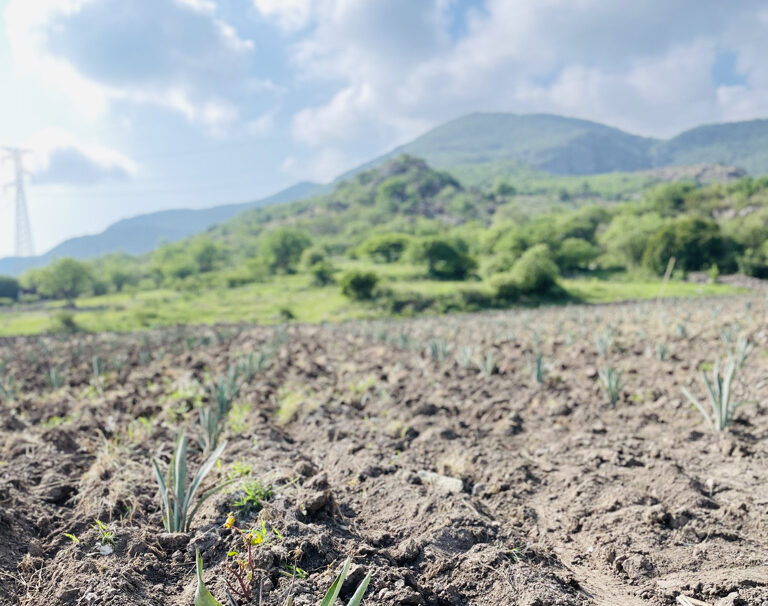
Once outside the city, farms with neat rows of newly-planted agave dot the landscape.
Our favorites mezcal distilleries or palenques in Oaxaca:
But, if you don’t have a car while traveling in Oaxaca, here are the best places in Oaxaca City to sip mezcal. Also, keep in mind, most restaurants carry a variety of local mezcals and offer delicious mezcal cocktails with each meal:
- In Situ Mezcaleria, tiny mezcal bar with hand-picked mezcals to taste, no cocktails
- Selva
- Mezcaleria Los Amantes
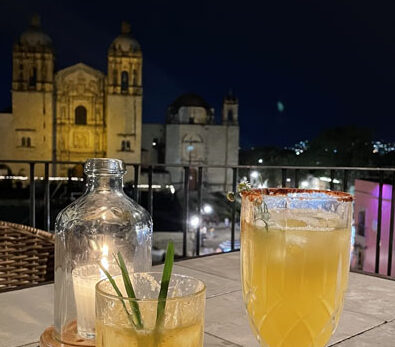
Mezcal can be enjoyed on its own, or mixed into a fruit-forward cocktail like here at Los Amantes.
Adventures Outside Oaxaca City
Our favorite part of visiting and then creating a Oaxaca Mexico travel guide was to be true to our passion! So of course we adventured outside the city for more than just mezcal!
Archeological Sites and Natural Wonders in Oaxaca Mexico
Most of us learned about the Mayas, Incas, and the Aztec civilizations in grade school. But there were also several other societies that flourished in Mesoamerica before the early explorers arrived. The Zapotec civilization was among them, and between 700 BC to 1500 AD they lived throughout the Oaxaca valley. Below are several of the areas where you can explore and learn more about the Zapotec culture.
- Monte Albán is just 6 miles from the city center to the west and yet feels like another world. One of the earliest settlements of Oaxaca. Monte Albán is 2.5 square miles and contains a vast network of terraces, plazas, and grand staircases. (Yes, you can still climb most of them.)
- Yagul, one of the most studied archeological sites in Oaxaca. Located east of the city near rock climbing, hiking trails, and caves with gorgeous views of the Oaxacan valley.
- Mitla, the 2nd most important archeological site in Oaxaca. Settled later than Monte Albán and nestled within the pueblo of San Pablo Villa de Mitla. Just east of Yagul.
- Hierve de Agua, while less of a site of archeological importance, Hierve de Agua is a natural wonder. There’s a ‘petrified’ waterfall with warm, thermal pools at the top along with an extensive irrigation system and terraces thought to have been developed by the Zapotecs more than 2,500 years ago. Hierve de Aqua lies east and up into the mountains from Mitla.
- The Tule Tree, thought to be the widest tree in the world, with a trunk larger than a giant Sequoia! About 5 miles from the city center, in the pueblo of Santa María del Tule.
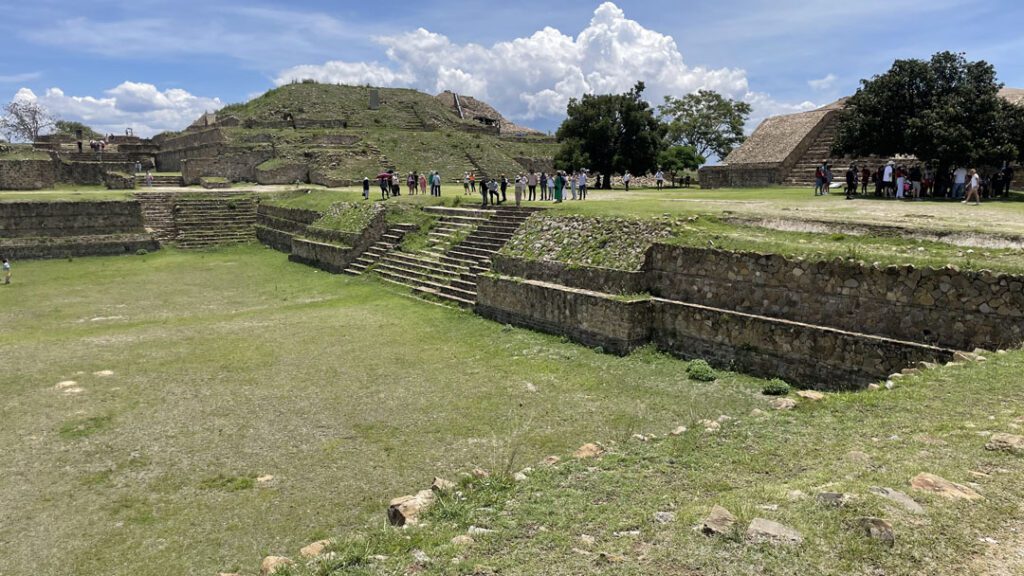
Come prepared for lots of walking to fully explore sites like Monte Alban, which is over 2 square miles!
Oaxaca’s Rock Climbing Areas
I would not adventure to Oaxaca solely to climb. But, if you happen to be coming down, check an extra bag with your sport climbing gear. You will be pleasantly surprised at the quality of the routes! In addition, the access to most climbing areas is within 20 minutes of where you park your car. And, there is a guidebook available at the local climbing gym, Muro Mondragon, in San Sebastian Tutla!
As with most rock climbing in tropical regions: prepare for overgrown trails, mosquitos, and respect the local farms you have to pass through to reach your climbing destinations. Here’s what’s located within an hour of the city:
- San Sebastian Tutla, here you will find over 50 routes, with a few easy climbs rated at 5.8 and 5.9.
- La Meca, just east of San Sebastian Tutla, with a few routes that go at 5.11a and up.
- Yagul, the development here is not as well-documented, but again, hard sport routes. And located close to the archeological site.
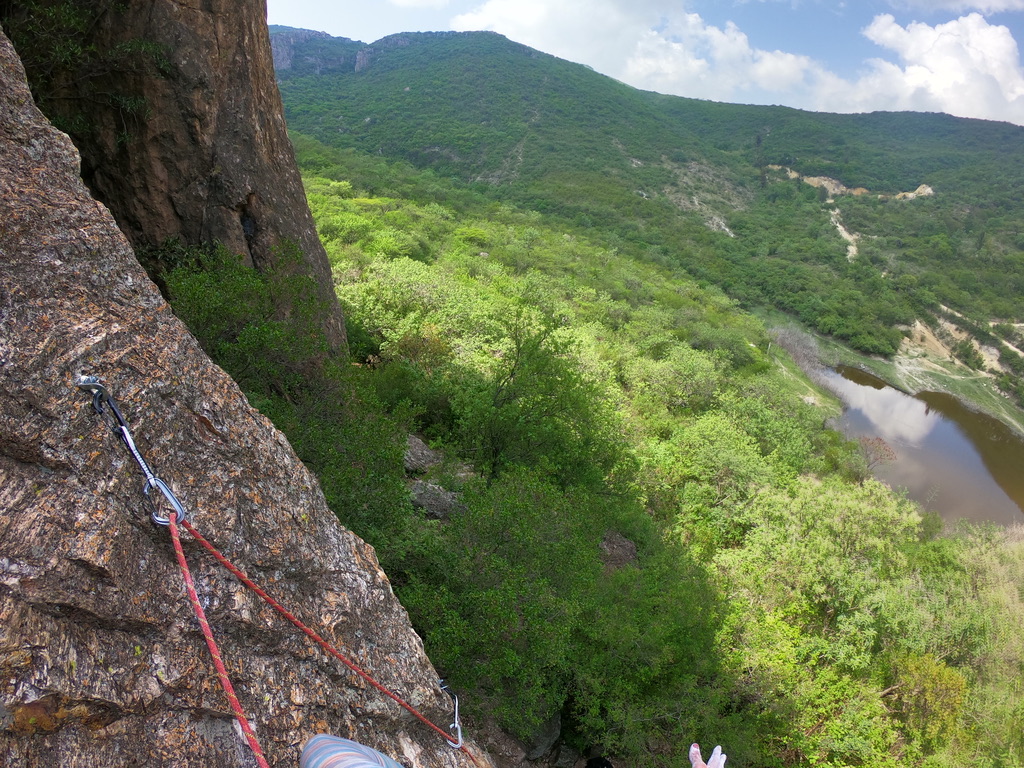
Steep sport climbing dominates the rock climbing scene in Oaxaca, so if you have the gear, and are comfortable leading at 5.10a and up, bring it!
Hiking and Mountain Biking in Oaxaca Valley
Our most exciting find while traveling in Oaxaca? The interconnected network of eco-tourism villages or pueblo mancomunados in the Sierra Norte. Situated at over 10,500ft, these tiny villages are self-governed and provide access to activities like hiking, mountain biking, zip-lining, along with beautifully rustic accommodations. Waking up in a small cabin in the cloud forest, surrounded by chirping birds and tropical ferns is definitely special!
In addition, you can book a guide (highly recommended) to help you navigate the poorly-signed network of trails that connect each village. We also discovered more information about the pueblo mancomunados trails and guiding services through these blogs:
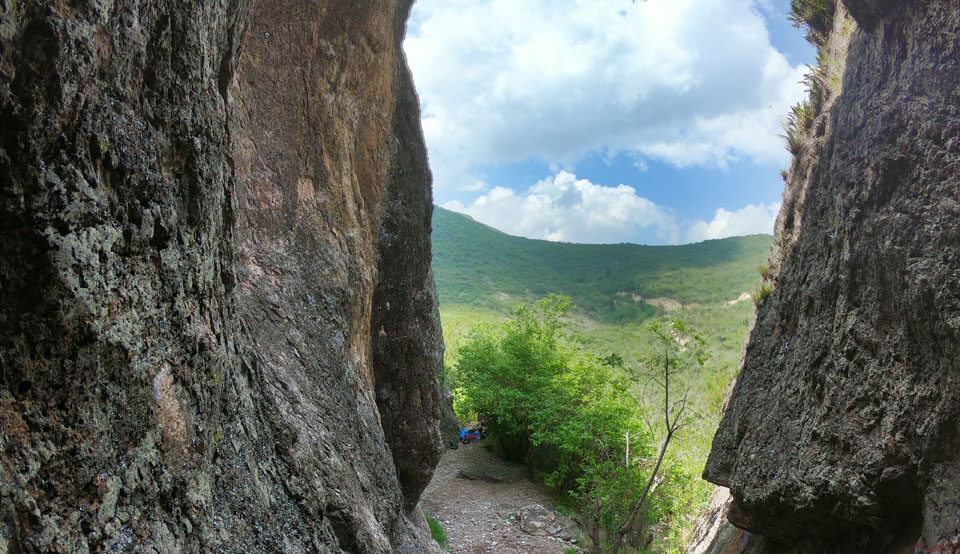
There’s plenty of hiking trails and rock climbing within an hour of Oaxaca City!
Oaxaca Mexico Travel Guide: Things to Do Before You Leave
1. Brush Up on Your Spanish
Unlike traveling to the more touristy areas of Mexico, not as many people will speak English in Oaxaca. So, familiarize yourself with some simple Spanish words and phrases. We use Duolingo every day! It’s free to download to your phone, and you will learn quickly with just 10 minutes of practice a day.
2. Pack Your Passport, Sentri, or Global Entry
Make sure you have a valid passport. And your Global Entry or SENTRI card. If you are within a month or two of the expiration of either your passport, Global Entry, or SENTRI, reapply before you leave.
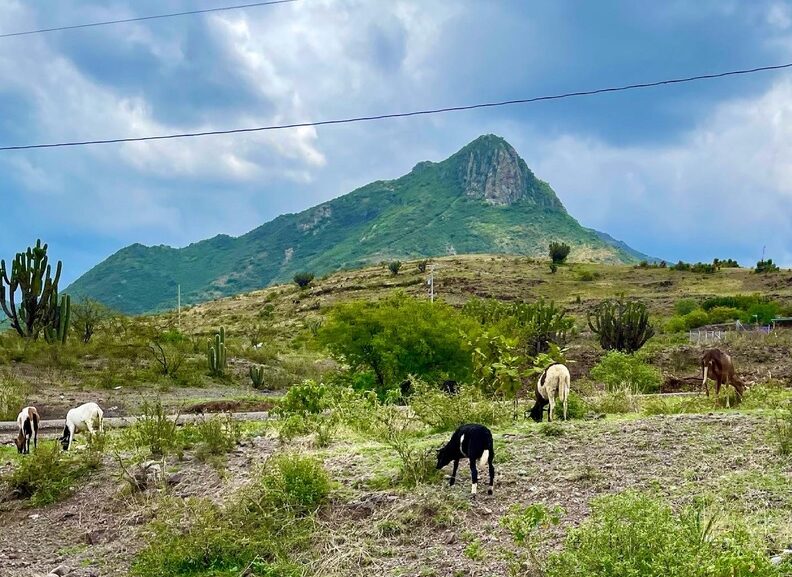
When driving outside of Oaxaca City, be prepared for lots of small winding roads and plenty of farm animals often grazing just off the pavement!
3. Buy Auto + Travel Insurance
If you will be renting a car in Oaxaca, book directly with a car rental agency like Eurocar or Avis. Avoid using sites like Kayak or Expedia. Then, if you need to make a change, you can avoid the incredible price-haggling at the counter. Why get the insurance? Because your U.S. or Canadian car insurance will not cover any accidents or theft in Mexico. And you can be arrested if you get in an accident and you do not have insurance, even if it’s not your fault.
In addition to car insurance, purchase flight insurance if you’re not 100% certain of your plans. This can be added to your ticket price through airlines like Volaris or AeroMexico.
4. Check With Your Bank + Cell Phone Carrier
Your Visa and MasterCard should work just fine in Oaxaca. And, often your cell phone carrier will have a Mexico plan you can opt into for the month. This includes talk, text, and data for your cell. However, to avoid any extra charges, or have a hold placed on a credit or ATM card, check in with your bank, the main credit card you will use, and your cell phone carrier before departing.
Sometimes you will need to turn on roaming to allow for connection to Mexico’s cell carriers, Telcel or Movistar. In addition, check to make sure the place you are staying at offers wifi. Then, you can connect easily to send emails or browse the web. Do not expect speedy service for video downloads and video chats, and be prepared to not have much service once you leave the city. Especially in the mountains.
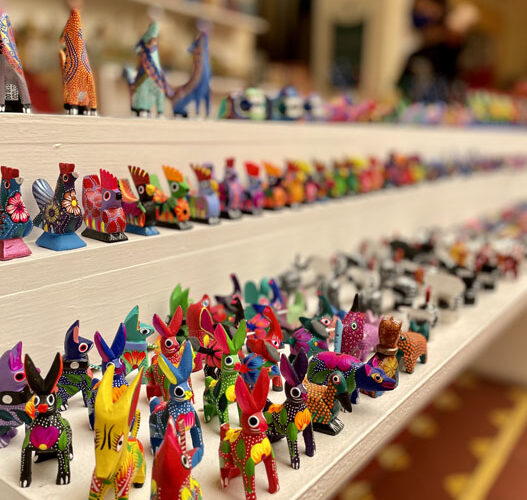
There’s such intricately detailed woodwork hand-crafted by the Oaxacan people. Support their efforts by bringing home a few unique pieces!
5. Exchange Dollars for Mexican Pesos
Unlike the more popular tourist destinations like Cabo or Cancun, American dollars are not widely accepted. Be respectful of the culture and currency, and exchange at least $200 dollars for pesos before you leave. You’ll need it for the taxi ride. To tip your hotel staff. To purchase anything at a local market. Once you arrive in Oaxaca, you can visit the Casa de Cambio and exchange more money as needed. There is a Citibank and Santander right downtown, but these will only be good if you want to use the ATM.
The exchange rate between the Mexican peso and the U.S. dollar is about 20 to 1. It does fluctuate, so check out the current exchange rate before departing for Oaxaca.
Oaxaca Mexico Travel Guide: Final Thoughts
We hope this Oaxacan travel guide inspires you to visit this magical place instead of a more well-trodden part of Mexico. Want more travel tips for Mexico? Read up on Valle de Guadalupe, Rosarito, and Ensenada.
How about Cuba? Check out our blog on traveling to the land of Classic Cars, Cigars, and Rock Climbing.
Road trips and camping? Here’s the rest of our travel blog posts.
Until next time, adios amigos!
Meredith McConvill
Recent Comments